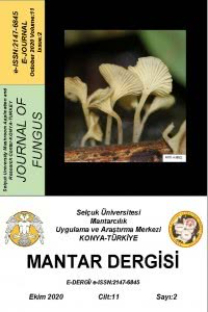İstanbul, Halkalı’dan toplanan bazidiyomalara göre Tricholomella constricta (Lyophyllaceae)’nın taksonomi ve yayılışına katkılar
Lyophyllaceae ailesine ait Tricholomella constricta (Fr.) Zerova ex Kalamees’in İstanbul-Halkalı’dan toplanan bazidiyomaları hem morfolojik ve hem de moleküler yöntemlerle çalışılmıştır. Klasik sistematiğe göre Tricholomella Zerova ex Kalamees genusu, T. constricta ve T. leucocephala gibi birden fazla tür içermektedir. Çalışmalarımız, bu iki türün genetik olarak birbirinden çok da farklı olmadığını, aynı tür içerisinde olduğunu ve annulus içeren ve de içermeyen türleri içerisine alan yeni bir deskripsiyon yapılması gerektiğini ortaya çıkarmıştır. Bu çalışmada arazi ve laboratuvar resimleri, kısa bir tartışma ve basit bir soyağacı verilmiştir.
Anahtar Kelimeler:
Fungal taksonomi, ITS, Sistematik, Türkiye
Contributions to the taxonomy and distribution of Tricholomella (Lyophyllaceae) based on the basidiomata collected from Halkalı, İstanbul
Basidiomata of Tricholomella constricta (Fr.) Zerova ex Kalamees belonging to Lyophyllaceae are collected from Halkalı-İstanbul and studied using both morphologic and molecular methods. According to the classical systematic the genus Tricholomella Zerova ex Kalamees contains more than one species, such as T. constricta and T. leucocephala. Our studies found out that the two species are not genetically too different, but conspecific and a new description is needed including the members with- or without annulus. In this study, illustrations, a short discussion and a simple phylogenetic tree are provided.
Keywords:
Fungal taxonomy, ITS, Systematics, Turkey,
___
- ReferencesAkata, I., Kabaktepe, Ş., Sevindik, M., Akgül, H. (2018). Macrofungi determined in Yuvacık basin (Kocaeli) and its close environs. Kastamonu University Journal of Forestry Faculty, 18 (2) 152-163.Akçay, M.E. (2019). A new edible macrofungus record for Turkey. Journal of Natural & Applied Sciences of East, 2 (1) 10-15.Altschul, S.F., Gish, W., Miller, W., Myers, E.W., Lipman, D.J. (1990). Basic local alignment search tool. Journal of Molecular Biology, (215) 403-410.Bellanger, J-M., Moreau, P-A., Corriol, G., Bidaud, A., Chalange, R., Dudova, Z., Richard, F. (2015). Plunging hands into the mushroom jar: a phylogenetic framework for Lyophyllaceae (Agaricales, Basidiomycota). Genetica, 143 (2) 169-194.Bon, M. (1999). Novitates - Tricholomatales (Marasmiaceae, Lyophyllaceae et Dermolomataceae). Documents Mycologiques, 29 (115) 33-34.Clémençon, H. (2009). Methods for Working with Macrofungi: Laboratory Cultivation and Preparation of Larger Fungi for Light Microscopy. Germany: Erchtesgadener Anzeiger.Consiglio, G., Orlandini, C., Setti, L., Moreno, G., Alvarado, P. (2011). Il genere Tricholomella in Italia. Rivista di Micologia, (2) 135-155.Doğan, H.H., Kurt, F. (2016). New macrofungi records from Turkey and macrofungal diversity of Pozantı-Adana. Turk J Bot, (40) 209-217.Gardes, M., Bruns, T.D. (1993). ITS primers with enhanced specificity for Basidiomycetes—application to the identification of mycorrhizae and rusts. Molecular Ecology, (2) 113-118.Hofstetter, V., Clémençon, H., Vilgalys, R., Moncalvo, J-M. (2002). Phylogenetic analyses of the Lyophylleae (Agaricales, Basidiomycota) based on nuclear and mitochondrial rDNA sequences. Mycological Research, 106 (9) 1043-1059.Kalamees, K. (2004). Palearctic Lyophyllaceae (Tricholomatales) in Northern and Eastern Europe and Asia. Scripta Mycologica, (18) 1-135.Keleş, A., Demirel, K., Uzun, Y., Kaya, A. (2014). Macrofungi of Ayder (Rize/Turkey) high plateau. Biological Diversity and Conservation, 7 (3) 177-183.Kirk, P.M., Cannon, P.F., Minter, D.W., Stalfers, J.A. (2008). Authors of Fungal Names. Wallingford, UK: CABI Bioscience. Knudsen, H., Vesterholt, J. (2008). Funga Nordica. Agaricoid, Boletoid and Cyphelloid Genera. Denmark: Nordsvamp.Mullis, K., Faloona, F.A. (1987). Specific synthesis of DNA in vitro via a polymerase-catalyzed chain reaction. Methods in Enzymology, (155) 335-350.Murray, M.G., Thompson, W.F. (1980). Rapid isolation of high molecular weight plant DNA. Nucleic Acids Research, 8 (19) 4321-4325.Ronquist, F., Huelsenbeck, J.P. (2003). MrBayes 3: Bayesian phylogenetic inference under mixed models. Bioinformatics, (19) 1572-1574.Sesli, E., Denchev, C.M. (2014). Onward (Continuously Updated). Mycotaxon Webpage. Available online at http://www. mycotaxon.com/resources/weblists.html.Stamatakis, A. (2006). RAxML-VI-HPC: maximum likelihood-based phylogenetic analyses with thousands of taxa and mixed models. Bioinformatics, (22) 2688-2690.Tamura, K., Peterson, D., Peterson, N., Stecher, G., Nei, M., Kumar, S. (2011). MEGA5: Molecular volutionary genetics analysis using maximum likelihood, evolutionary distance, and maximum parsimony methods. Molecular Biology and Evolution, 28 (10) 2731-2739.White, T.J., Bruns, T.D., Lee, S., Taylor, J.W. (1990). Amplification and direct sequencing of fungal ribosomal RNA genes for phylogenetics. M.A. Innis, D.H. Gelfand, J. Sninsky, T.J. White (Ed.) PCR protocols: a guide to methods and applications. Academic, (482 pp). San Diego.
- ISSN: 2147-6845
- Yayın Aralığı: Yılda 2 Sayı
- Başlangıç: 2010
- Yayıncı: Selçuk Üniversitesi Mantarcılık Uygulama ve Araştırma Merkezi Müdürlüğü
Sayıdaki Diğer Makaleler
Çevre Kirliliği Araştırmalarında Mantarların Kullanımının İncelenmesi
Yalova İli Fungal Spor Takvimi (2005)
Demet YILMAZKAYA, Hasan AKGÜL, Mustafa Kemal ALTUNOĞLU, Aycan TOSUNOĞLU, Adem BIÇAKÇI
Bitki Patojeni Fungusların Evrimini Etkileyen Bazı Faktörler
Ayten DİZKIRICI TEKPINAR, Ayşenur KALMER, İsmail ACAR
Helvella phlebophora, Türkiye İçin Yeni Bir Askomiset Kaydı
Aladağlar ve Bolkar Dağları (Türkiye)’ndan Belirlenen Sürme Mantarları
Banu COŞKUN AKÇAY, HASAN HÜSEYİN DOĞAN
Gautieria graveolens’in Türkiye’de Yeniden Keşfi
Yasin UZUN, Semiha YAKAR, ABDULLAH KAYA
Kastamonu ve Erzincan İllerindeki Tereyağlardan İzole Edilen Funguslar Üzerine Araştırmalar
